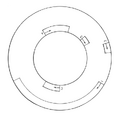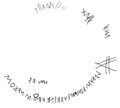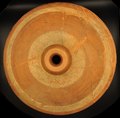VB·3.2: Difference between revisions
No edit summary |
No edit summary |
||
| (8 intermediate revisions by the same user not shown) | |||
| Line 1: | Line 1: | ||
{{inscription | {{inscription | ||
|reading= | |reading=inou : ea | ||
|reading_lepontic={{c|A}}{{c|E}}{{c|separator}}{{c|U| | |reading_lepontic={{c|A}}{{c|E}}{{c|separator}}{{c|U|U12}}{{c|O|O3}}{{c|N}}{{c|I}} | ||
|direction=sinistroverse | |direction=sinistroverse | ||
|letter_height_min=0 | |letter_height_min=0.4 cm | ||
| | |letter_height_max=1 cm | ||
| | |letter_number_min=6 | ||
|word_number=2 | |word_number=2 | ||
|line_number=1 | |line_number=1 | ||
|corpus=Cisalpine Celtic | |||
|script=North Italic script | |script=North Italic script | ||
|alphabet=Lepontic alphabet | |||
|object=VB·3 Ornavasso | |object=VB·3 Ornavasso | ||
|position=shoulder, outside | |position=shoulder, outside | ||
| Line 16: | Line 17: | ||
|condition=complete | |condition=complete | ||
|type_inscription=unknown | |type_inscription=unknown | ||
|language= | |language=Celtic | ||
| | |linguistic_ascription=prob. | ||
|meaning= | |meaning='Inu ...' (?) | ||
|whatmough=304 | |whatmough=304 a | ||
|tibiletti_bruno=10 | |tibiletti_bruno=10 | ||
|solinas=128 4 | |solinas=128 4 | ||
|morandi=48 B1 | |morandi=48 B1 | ||
|source_detail=Morandi 2004: | |source_detail=Morandi 2004: 550–552 no. 48 B1 | ||
|checklevel= | |checklevel=1 | ||
|problem= | |problem=literature | ||
|disambiguation=VB·3 | |disambiguation=VB·3 | ||
}} | }} | ||
==Commentary== | ==Commentary== | ||
First published in {{bib|Bianchetti 1895}}: 69 f. (no. 21). Examined for LexLep on 20<sup>th</sup> April 2024. | |||
Images in {{bib|Lejeune 1987}}: 508, fig. 6 (drawing), {{bib|Solinas 1995}}: tav. LXXIa (photo), {{bib|Piana Agostinetti 1972}}: tav. XXXI.12 (drawing), {{bib|Graue 1974}}: Taf. 30.3 (drawing), {{bib|Caramella & De Giuli 1993}}: tav. LXXVII.2 (drawing), {{bib|Morandi 2004}}: 566, fig. 12.48 (drawing). | |||
Inscribed above the sequence {{w||uinom}} of [[VB·3.1]], below the innermost of the white bands (length 2.7 cm). The distance between upsilon and epsilon is larger than those between the other letters, and two adjacent round marks are situated where a single-dot separator might be expected; the marks themselves, however, look much like other spots of surface damage and are not evidently intentional. Bianchetti read a single sequence ''inouea'' (also {{bib|Kretschmer 1905}}: 99, no. 21, {{bib|Rhŷs 1913}}: 62, no. 20 (a)); the mark was considered relevant by {{bib|Whatmough 1933}}: 111–113, no. 304 (b) and {{bib|Tibiletti Bruno 1978}}: 144, 146 (also {{bib|Tibiletti Bruno 1981|1981}}: 162–164, no. 10), who proposed to read the initial group of scratches as a very uneven mu ''mou.ea'', including a faint oblique scratch crossing iota and nu (also {{bib|Lejeune 1987}}: 497, {{bib|Morandi 2004}}: 550–552 no. 48 B1). Undecided, but including the separator, {{bib|Solinas 1995}}: 375, no. 128 4. | |||
We consider the scratch which is supposed to form Tibiletti's ramshackle mu unintentional, and the separator at least doubtful – clear separators in the inscriptions on the flask consist of at least two vertcally arranged dots, though the distance between upsilon and epsilon does indicate two separate sequences. Cf. specifically [[VB·3.3]] for a short inscription with internal separation, also with a first part which ends in ''ou''. | |||
{{bib|Pisani 1964}}: 286 f., no. 124 (b), who seems to have worked with Whatmough's inaccurate drawing of the inscriptions' placement on the flask, considered the four short inscriptions on the vase to form a sentence ''etninou.ealutou:iutuni:'', separated for aesthetic reasons. Rather more plausible is Rhŷs' and Lejeune's ({{bib|Lejeune 1987|1987}}: 497) assumption that all the sequences are abbreviations of personal names; {{bib|Morandi 1999}}: 172, no. 17 suggests that they record the names of the gift givers ("sottoscrizioni" in {{bib|Morandi 2004|2004}}: 552). The sequence {{w||inou}} may indeed be a personal name or abbreviation; ⟨ou⟩ appears to denote long /{{p||ū}}/ (see the word page). Cf. especially [[VB·3.3]] {{w||lutou}}:''iii'', which is applied directly opposite the present inscription. {{w||ea}} is obscure; see {{bib|Lejeune 1987}}: 497, n. 19. | |||
See also {{bib|Lattes 1896}}: 106 f., n. 16, {{bib|Giussani 1902}}: 55 f., {{bib|Piana Agostinetti 1972}}: 272, no. 12, '''{{bib|Morandi 1999b}}: 308–312, no. 4'''. | |||
<p style="text-align:right;>[[User:Corinna Salomon|Corinna Salomon]]</p> | |||
{{bibliography}} | {{bibliography}} | ||
Latest revision as of 17:58, 29 October 2024
| Inscription | |
|---|---|
| Reading in transliteration: | inou : ea |
| Reading in original script: | |
|
| |
| Object: | VB·3 Ornavasso (bottle) (Inscriptions: VB·3.1, VB·3.2, VB·3.3, VB·3.4, VB·3.5) |
| Position: | shoulder, outside |
| Orientation: | 0° |
| Direction of writing: | sinistroverse |
| Script: | North Italic script (Lepontic alphabet) |
| Letter height: | 0.4–1 cm0.157 in <br />0.394 in <br /> |
| Number of letters: | 6 |
| Number of words: | 2 |
| Number of lines: | 1 |
| Workmanship: | scratched after firing |
| Condition: | complete |
|
| |
| Archaeological culture: | La Tène D [from object] |
| Date of inscription: | first half of 1st c. BC [from object] |
|
| |
| Type: | unknown |
| Language: | prob. Celtic |
| Meaning: | 'Inu ...' (?) |
|
| |
| Alternative sigla: | Whatmough 1933 (PID): 304 a Tibiletti Bruno 1981: 10 Solinas 1995: 128 4 Morandi 2004: 48 B1 |
|
| |
| Sources: | Morandi 2004: 550–552 no. 48 B1 |
Images
|
| ||||
Commentary
First published in Bianchetti 1895: 69 f. (no. 21). Examined for LexLep on 20th April 2024.
Images in Lejeune 1987: 508, fig. 6 (drawing), Solinas 1995: tav. LXXIa (photo), Piana Agostinetti 1972: tav. XXXI.12 (drawing), Graue 1974: Taf. 30.3 (drawing), Caramella & De Giuli 1993: tav. LXXVII.2 (drawing), Morandi 2004: 566, fig. 12.48 (drawing).
Inscribed above the sequence uinom of VB·3.1, below the innermost of the white bands (length 2.7 cm). The distance between upsilon and epsilon is larger than those between the other letters, and two adjacent round marks are situated where a single-dot separator might be expected; the marks themselves, however, look much like other spots of surface damage and are not evidently intentional. Bianchetti read a single sequence inouea (also Kretschmer 1905: 99, no. 21, Rhŷs 1913: 62, no. 20 (a)); the mark was considered relevant by Whatmough 1933: 111–113, no. 304 (b) and Tibiletti Bruno 1978: 144, 146 (also 1981: 162–164, no. 10), who proposed to read the initial group of scratches as a very uneven mu mou.ea, including a faint oblique scratch crossing iota and nu (also Lejeune 1987: 497, Morandi 2004: 550–552 no. 48 B1). Undecided, but including the separator, Solinas 1995: 375, no. 128 4.
We consider the scratch which is supposed to form Tibiletti's ramshackle mu unintentional, and the separator at least doubtful – clear separators in the inscriptions on the flask consist of at least two vertcally arranged dots, though the distance between upsilon and epsilon does indicate two separate sequences. Cf. specifically VB·3.3 for a short inscription with internal separation, also with a first part which ends in ou.
Pisani 1964: 286 f., no. 124 (b), who seems to have worked with Whatmough's inaccurate drawing of the inscriptions' placement on the flask, considered the four short inscriptions on the vase to form a sentence etninou.ealutou:iutuni:, separated for aesthetic reasons. Rather more plausible is Rhŷs' and Lejeune's (1987: 497) assumption that all the sequences are abbreviations of personal names; Morandi 1999: 172, no. 17 suggests that they record the names of the gift givers ("sottoscrizioni" in 2004: 552). The sequence inou may indeed be a personal name or abbreviation; ⟨ou⟩ appears to denote long /ū/ (see the word page). Cf. especially VB·3.3 lutou:iii, which is applied directly opposite the present inscription. ea is obscure; see Lejeune 1987: 497, n. 19.
See also Lattes 1896: 106 f., n. 16, Giussani 1902: 55 f., Piana Agostinetti 1972: 272, no. 12, Morandi 1999b: 308–312, no. 4.
Bibliography
| Bianchetti 1895 | Enrico Bianchetti, I sepolcreti di Ornavasso [= Atti della Società di Archeologia e Belle Arti della provincia di Torino 6], Torino: Paravia 1895. |
|---|---|
| Caramella & De Giuli 1993 | Pierangelo Caramella, Alberto De Giuli, Archeologia dell'Alto Novarese, Mergozzo: Antiquarium Mergozzo 1993. |







